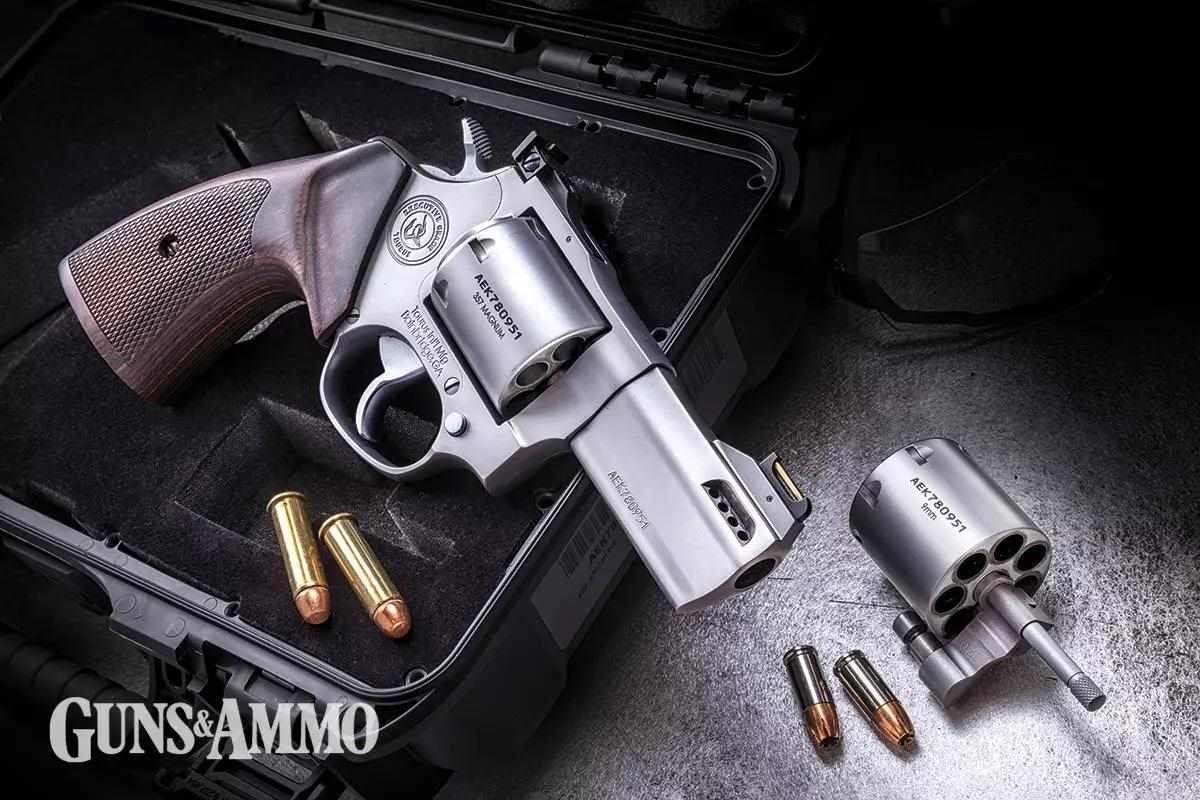The Taurus 692 Executive Grade convertible revolver is the latest in a series of enhanced defensive handguns. In the company’s wheelgun C-suite, the double-action/single-action (DA/SA) Taurus 692 joins the previously promoted Taurus 856 (.38 Special +P, $682), Taurus 605 (.357 Magnum, $758), and Taurus Judge (.45 Colt/.410, $947) Executive Grade models. Each of these guns are assembled and tuned to a higher degree of performance by specialized Taurus gunsmiths. Executive Grade guns are also distinctive for the hand-polished stainless-steel finish, presentation-grade laminate wood grips, and multi-layer Nanuk hard cases with custom-cut foam interiors.
The Taurus 692 is a seven-shot revolver built on the brand’s medium steel frame. The 692 has been often cataloged with the Tracker series of Taurus revolvers, and the solid topstrap frame has been adapted to accommodate chamberings from the .17 HMR to .44 Magnum. Alongside the Tracker 992 in .22 LR/.22 Magnum, the Taurus 692 uses a quick-change cylinder system to adapt and accept multiple cartridges using bullets of similar diameter. The Taurus 692 includes two cylinders, one for .357 Mag. and .38 Special cartridges — including .38 SPL +P loads — and a second cylinder for 9mm cartridges. Both cylinders have a seven-round capacity. Also provided are five, seven-round moon clips — called “Stellar Clips” by Taurus. These improve function when shooting the rimless 9mm.
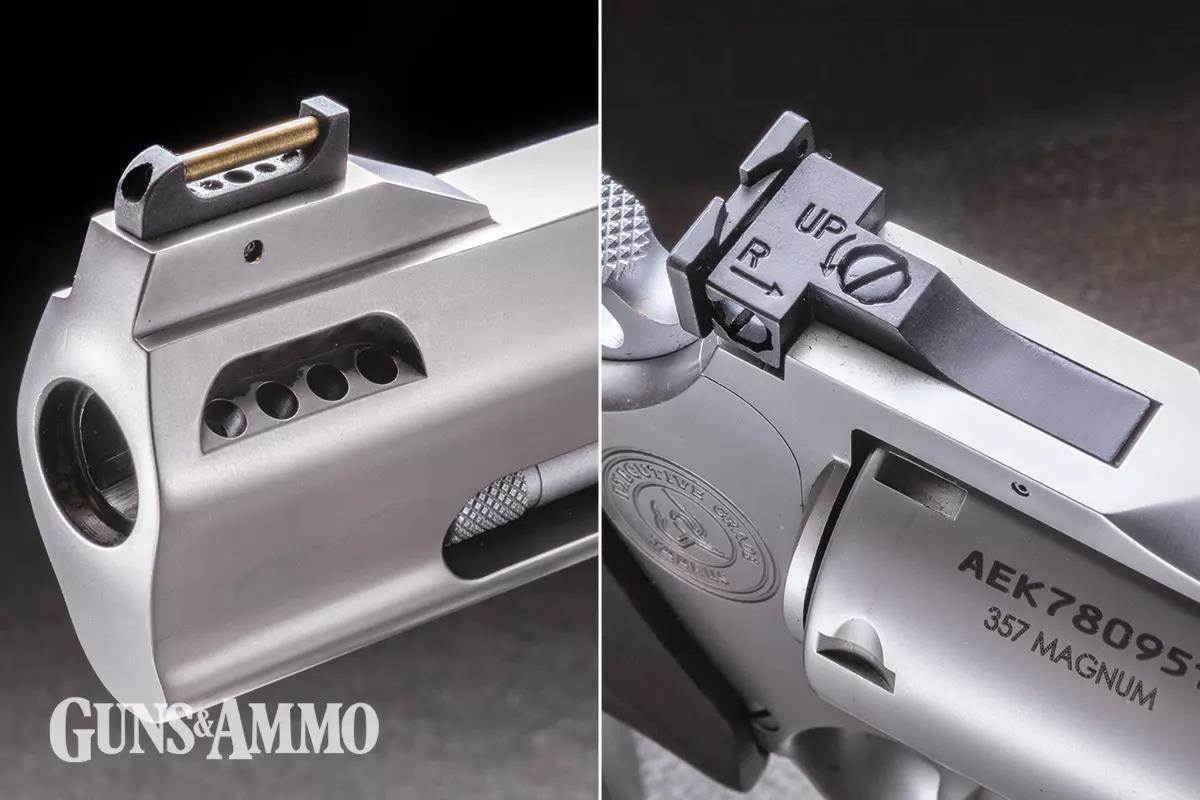
Looking specifically at the Taurus 692 Executive Grade, the revolver features a 3-inch target barrel. It may seem a misnomer to ascribe the terms “target” and “match” to such a short barrel, but Guns & Ammo took it to mean just that. Like other Executive Grade features, this is a best-quality component for Taurus. The barrel is ported with eight circular vents, four on each side of the front sight, allowing propellant gases to escape up like a booster to counter muzzle rise during recoil. The barrel features a full-length underlug, shrouding the ejector rod.
The front sight incorporates a brass rod in a steel fixture, not unlike a fiber-optic sight. Although the exposed brass does not increase the sight’s light transferring capability, it adds to the gun’s traditional and attractive aesthetic. It also presents the shooter with a proven front-bead-style sight picture. It’s paired with a black, square-notch target-style rear sight that is adjustable for windage and elevation using a small flathead screwdriver.
Advertisement
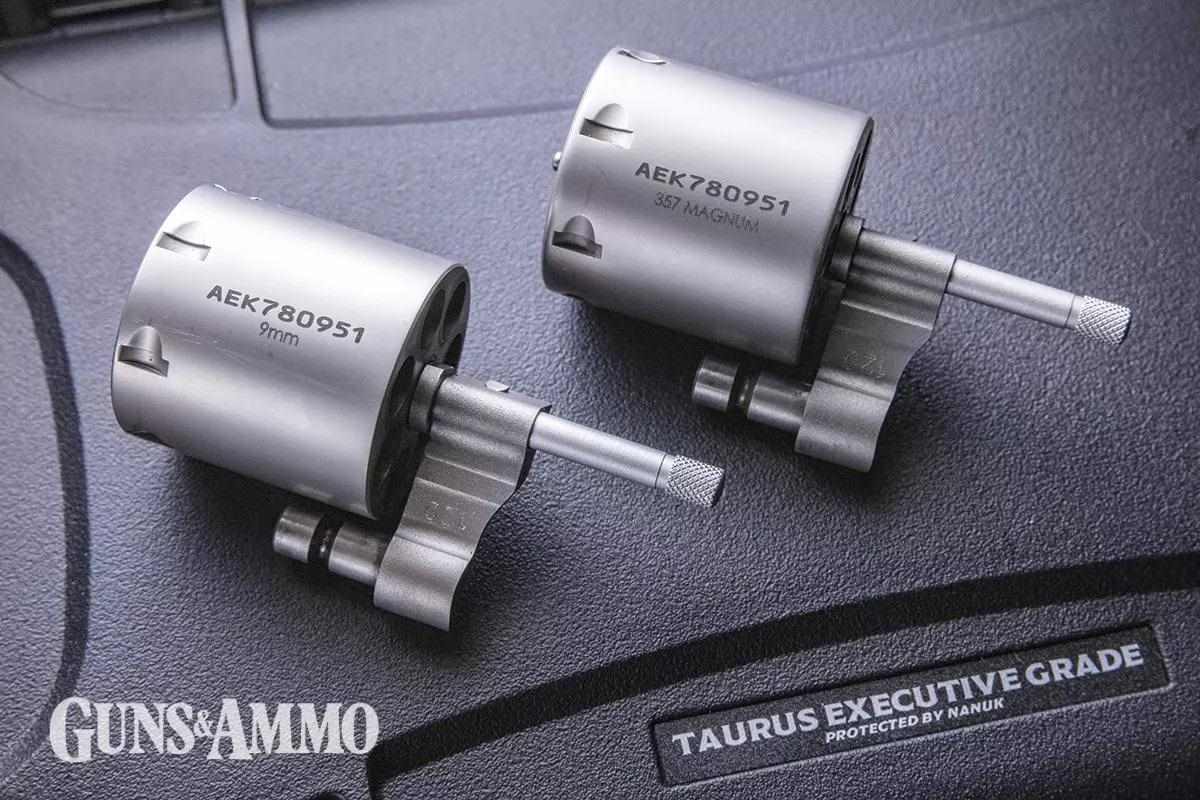
Cylinder Changes
Two interchangeable cylinder assemblies include a cylinder, ejector rod, extractor, and yoke. The cylinders are not fluted, but the cylinder-stop notches are cleanly machined with relieved approaches. We liked that both cylinders were clearly laser etched with the correct chambering, “357 MAGNUM” and “9mm”, as well as the revolver’s serial number, effectively matching the cylinders to the gun.
Exchanging the cylinders is a simple process. With an unloaded firearm, release the cylinder by pressing forward on the checkered cylinder catch. The cylinder swings out to the left side of the frame. Once released, depress the cylinder yoke catch button, located at the lower-front corner on the right side of the frame. With the button depressed, the cylinder assembly can be pulled forward and removed. Note the channel around the circumference of the yoke’s mounting lug where the catch engages the assembly. To reinstall, insert the yoke’s mounting lug into the frame while pressing the yoke catch so that the assembly seats completely. Release the yoke catch to lock the assembly into the frame.
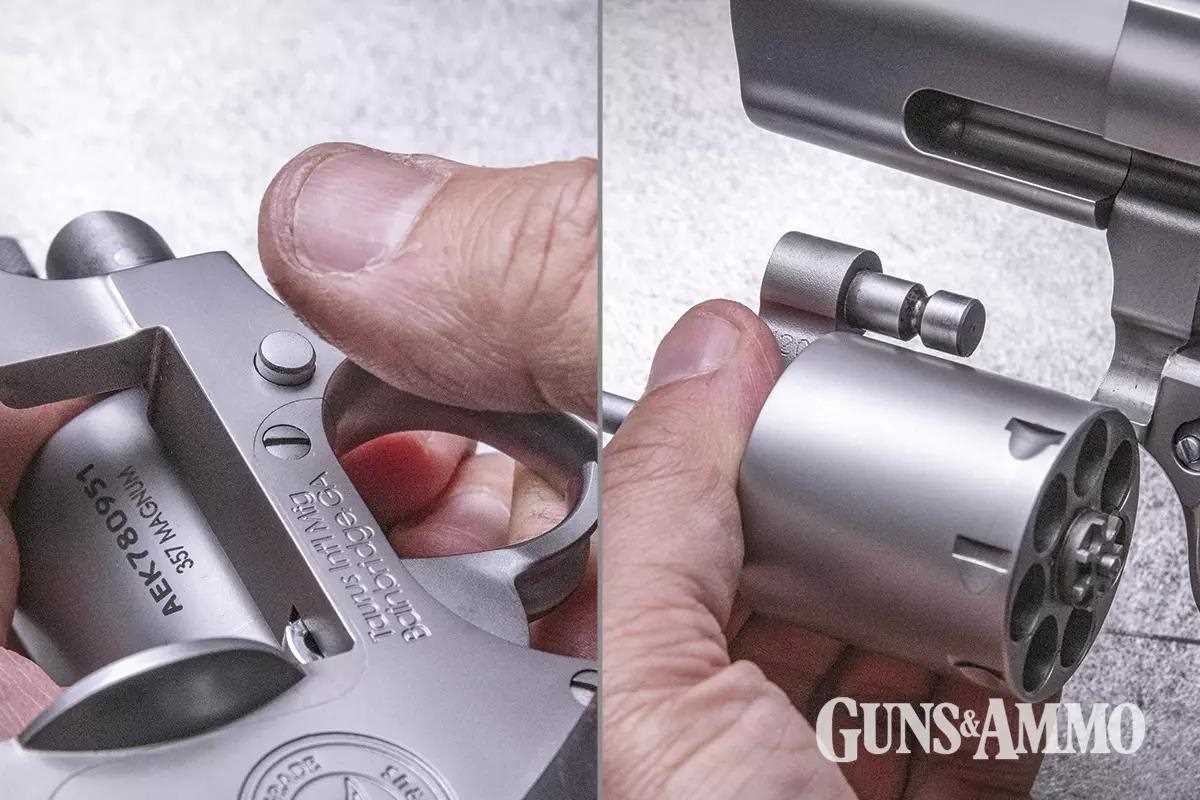
Steady & Fast
Being a DA/SA design, there are two ways to fire the 692; pulling the trigger rearward initiates the double-action firing sequence. A full trigger press powers the hammer into its cocked position (one action) and release the sear to drop the hammer (second action). In single action, the shooter pre-cocks the hammer by drawing back the checkered spur. The action also moves the trigger nearly all the way to the rear of the triggerguard. Afterward, only a short and light triggerpull is required to release the sear.
Advertisement
With either method of operation, as the hammer moves toward its cocked position, the revolver’s other internal mechanisms are also engaged. First, the cylinder stop, located between the trigger and cylinder, drops out of engagement with the cylinder notches and recedes into the frame. Once the cylinder is unlocked, the hand emerges from the frame to engage the star-like gear on the cylinder’s extractor. Upward movement of the hand rotates the cylinder counterclockwise one position. As the rotation completes — but before the sear is released — the cylinder stop reemerges to lock the cylinder into position for firing.
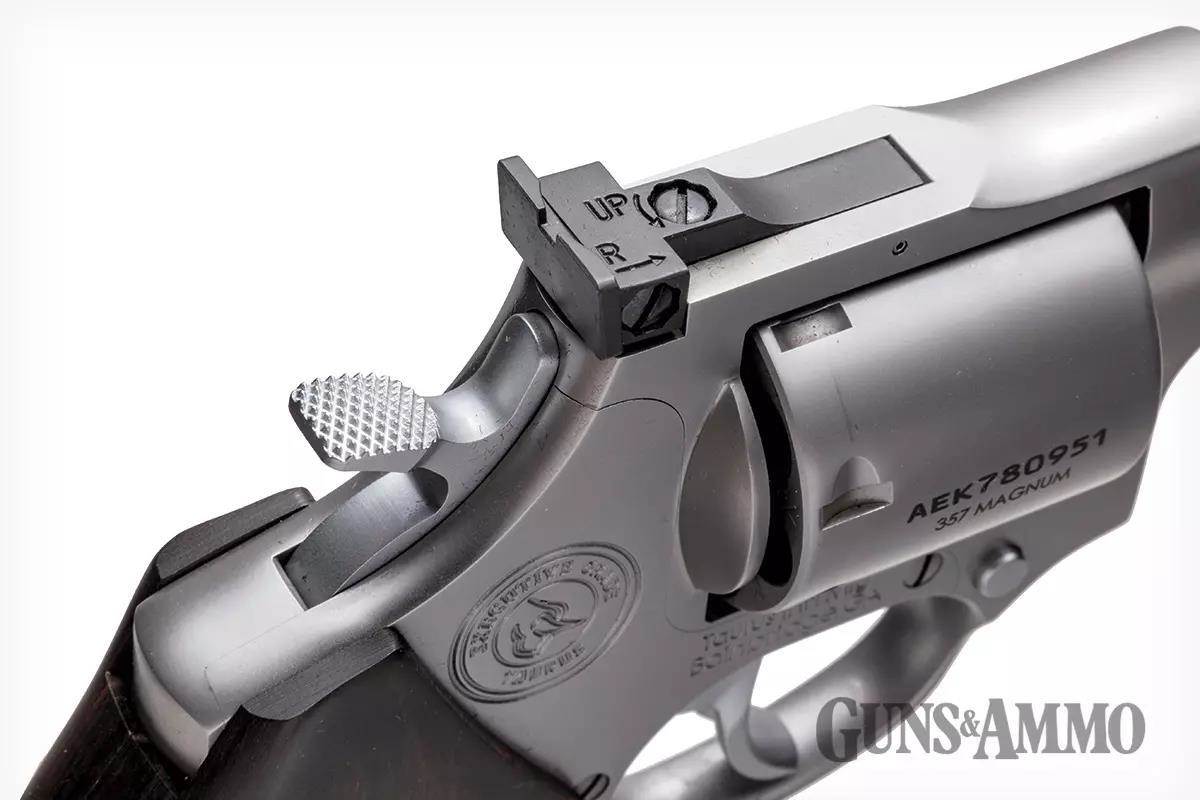
Taurus utilizes a transfer-bar safety in the 692 Executive Grade, incorporating another function. Unlike early cartridge revolvers, modern handguns do not incorporate a firing pin as part of the hammer, nor does the hammer directly contact the firing pin in most modern revolvers. Instead, a component called the “transfer bar” completes the connection, but only when the trigger is pulled. As the trigger travels rearward, the transfer bar ascends between the hammer and the firing pin. It will stay in its upward position as long as the trigger is fully pressed, and its function is to transfer the energy of the hammer strike to the firing pin. If the trigger is not pressed fully, the bar will not reach its apex position, and the hammer cannot exert force on the firing pin. The arrangement renders even a loaded and cocked revolver safe from drops or unintended impacts to the hammer.
The trigger is a wide, curved lever with a smooth face. Even in the age of flat-faced triggers, double-action revolvers and pistols usually offer a curved trigger. Double-action pull weights tend to be heavier than single-action or striker-fired triggers, so the wide, curved trigger increases finger engagement and facilitates greater leverage. Guns & Ammo’s staff measured the pull weight for the sample 692 Executive Grade. The double-action pull averaged 10 pounds, 10 ounces, compared to its 6-pound single-action pull.
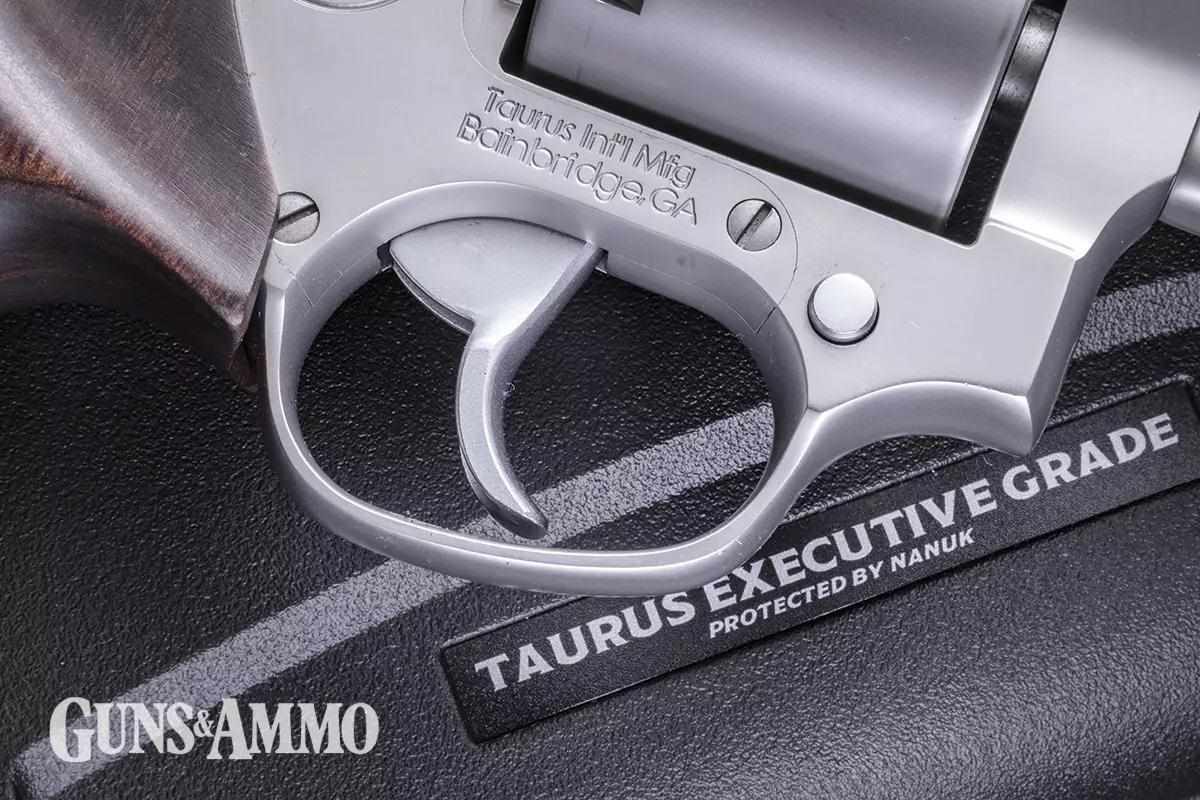
Throughout testing, we were impressed by the trigger. Despite the weight of the double-action pull, the trigger offers a smooth, consistent arc of travel, free of grit, walls, mush, or stops. The single-action pull is equally clean, with only the slightest hint of take-up; most shooters would simply press right through it. It was only detected during careful examination of the revolver’s mechanics, but it was never felt on the range.
The stocks on the Taurus 692 Executive Grade are a dark-stained laminate wood with ergonomic relief cuts and diamond-pattern checkering. The 692 frame is technically a round-butt design, but the Executive Grade stocks provide a distinctly square-butt look and feel. There is a small flathead screw that secures the stocks together, and it features handsome brass fittings that complement the front sight and suggest a traditional appearance. The aesthetic is further enhanced by the polished metal finish and the attractive contours that define Executive Grade models; the taper beneath the muzzle, the ramp to the rear sight, the slope of the frame by the hammer, and the profile of the triggerguard and grips. Given its appearance, it would be easy to lose sight of the fact that the 692 Executive Grade is a serious defensive revolver. It’s also one of the most adaptable guns in its category for its defensive cartridge compatibility.
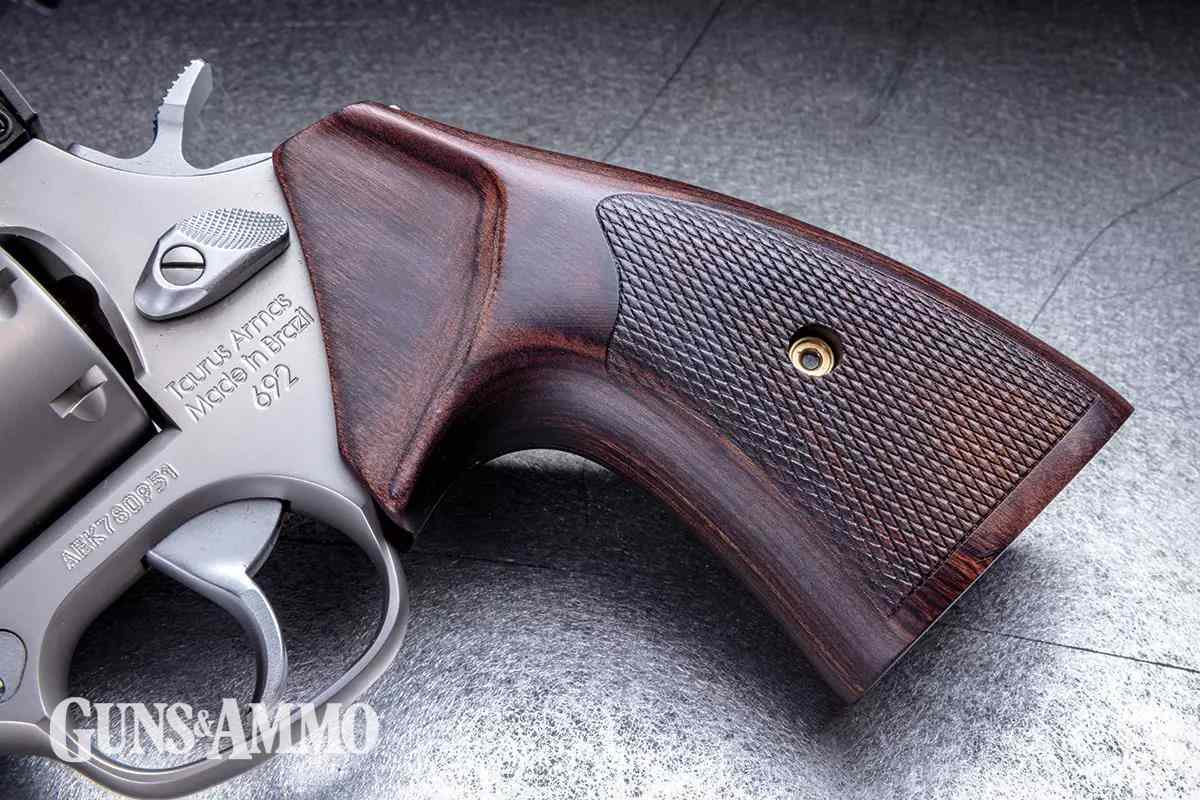
At the Range
To put its versatility to the test, G&A’s evaluation incorporated both cylinders and a total of five loads comprised of .357 Mag., .38 Special, .38 Special +P, and 9mm ammunition from five different makers using five different bulletweights. Most striking was the consistent performance. Less than an inch separated the best accuracy results averaged from five, five-shot groups. The largest average group size measured just more than 3 inches, which we agreed is excellent for an iron-sighted 3-inch gun at 25 yards.
During testing, the adjustable rear sight became one of the staff’s favorite features. Given the diversity of ammunition, being able to give the sight a couple clicks up or down to center punch targets was convenient and very helpful. We also appreciated the barrel’s porting; it did an admirable job taming recoil. Paired with the 692’s weight, which measured 34.8 ounces, unloaded, even the defensive .357s were quite manageable to shoot. Finally, the thorough dehorning that Executive Grade revolvers receive at the factory was noted for praise. For all of our manipulations, there were no bites, cuts or scratches.
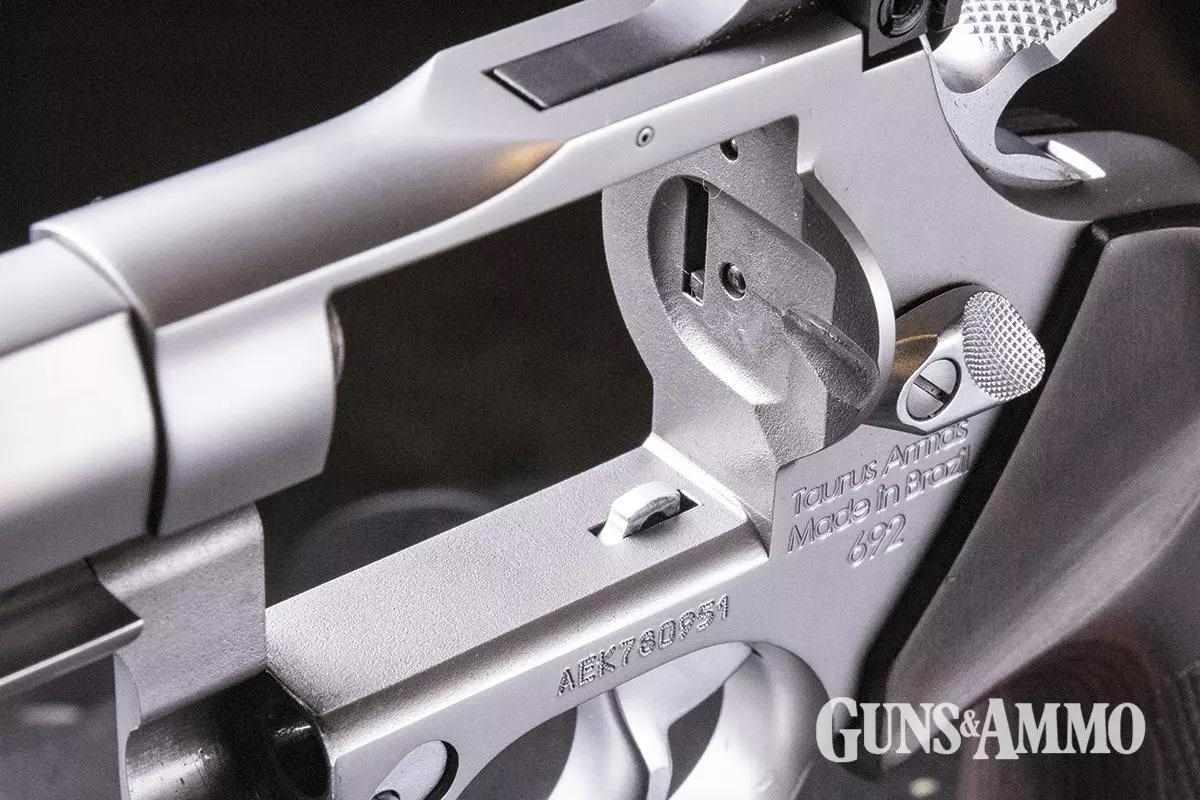
The Taurus 692 Executive Grade scored highly for its fit, function, and ammunition flexibility. The trigger, sights, and overall shootability offer an experience par excellence. It pairs a professional appearance with refined construction, all for a reasonable price. Anyone in the market for, or curious to try a high-quality defensive revolver should put the Taurus 692 Executive Grade at the top of their list.
Taurus 692 Executive Grade
- Type: Revolver, double action (DA)/single action (SA)
- Cartridge: .357 Mag./.38 Spl./9mm
- Capacity: 7 rds.
- Barrel: 3 in., stainless steel, ported, 1:10-in. twist
- Overall Length: 8.1 in.
- Width: 1.5 in.
- Height: 5.66 in.
- Weight: 2 lbs., 2.8 oz. (tested)
- Materials: Stainless steel; wood
- Finish: Polished (stainless steel)
- Sights: Brass insert (front); adjustable notch (rear)
- Trigger: 10 lbs., 10 oz. (DA); 6 lbs. (SA) (tested)
- MSRP: $1,107
- Manufacturer: Taurus, 229-515-8464, taurususa.com
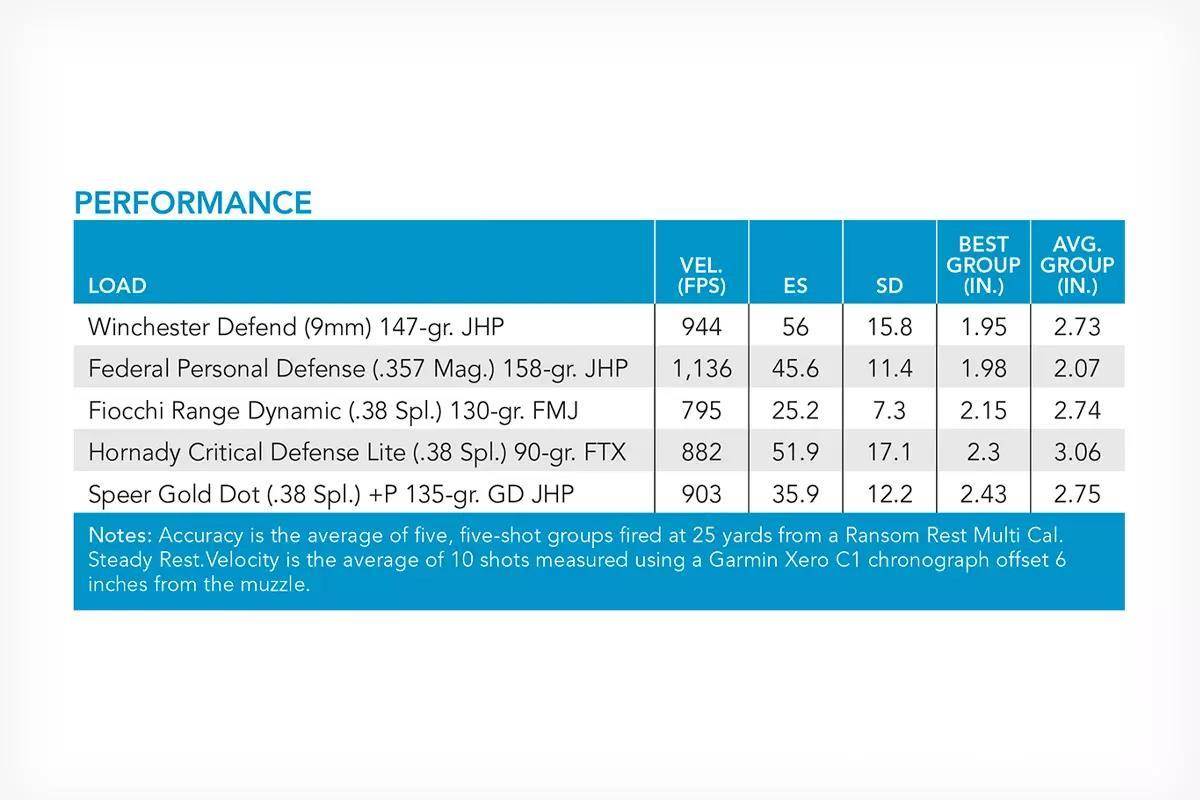
Read the full article here


